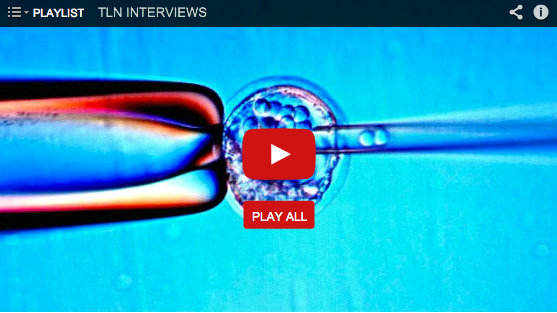Professor Caplan is “The father of the mesenchymal stem cell (MSC)”. In this clip, he describes a mouse experiment using human MSCs in a mouse model of MS. The experiment shows that it’s possible to place human cells in mice that have normal immune systems. He continues to discuss the astounding results.
Professor Arnold Caplan discusses mesenchymal stem cell therapy for multiple sclerosis
VIDEO – The Science of Mesenchymal Stem Cells and Regenerative Medicine – Arnold Caplan PhD (Part 7 of 7)
In this final segment, Prof. Caplan discusses: Mesenchymal stem cells make anti-bacterial molecules, How retro-orbital injections of human MSCs cure mice with cystic fibrosis infected by pneumonia aeruginosa 70% of the time, The process by which MSCs kill bacteria in the body, Clinical trial for using MSCs to treat sepsis, “MSCs are drug stores for sites of injury or inflammation. They are site regulated, multi-drug delivery vehicles”, MSC transitions: ostegenic, trophic and immunomodulatory, MSCs are not stromal cells. They are not part of the connective tissue, The name of the MSC has changed. It is a “Medicinal Signaling Cell” and has nothing whatsoever to do with “stem-ness”, Cell plasticity, transdifferentiation in the mesengenic process.
VIDEO – The Science of Mesenchymal Stem Cells and Regenerative Medicine – Arnold Caplan PhD (Part 6)
In part 6, Prof. Caplan discusses Trophic properties of mesenchymal stem cells; MSCs for heart disease; MSCs homing to heart injury site and also to skin incision site; MSCs limit left ventricular thinning following infarction; Trophic properties of MSCs: anti-apoptotic, anti-fibrotic, anti-scarring, angiogenic, mitotic; phase 1 data for allogeneic MSCs show fewer arrhythmias, prompt heart rate recovery, and improved lung function; autologous adipose tissue-derived stromal vascular fraction for treatment of chronic heart disease; Active mesenchymal stem cell clinical trials around the world; Induction therapy with autologous MSCs in kidney transplants; MSCs can coax neural stem cells to become oligodendrocytes, curing mice with MS using allogeneic human MSCs.
VIDEO – The Science of Mesenchymal Stem Cells and Regenerative Medicine – Arnold Caplan PhD (Part 5)
In part 5, Prof. Caplan discusses: Mesenchymal stem cells produce huge quantities of bio-molecules, some of which are immunosuppressive; MSCs put up a curtain of molecules around themselves that allows donor (allogeneic) MSCs to be transplanted into a recipient free from immune response; The bio-chemical mechanism of how MSCs shield themselves from host T Cells; Allogeneic hematopoietic stem cell business model; Treatment of graft vs. host disease in children and adults; Treatment of Crohn’s disease with allogeneic mesenchymal stem cells.
VIDEO – The Science of Mesenchymal Stem Cells and Regenerative Medicine – Arnold Caplan PhD (Part 4)
In part 4, Prof. Caplan talks about isolating mesenchymal stem cells from bone marrow using specialized; calf serum choosing different assays to prove multipotency – osteogenesis, chondrogenesis, adipogenesis; point of care with autologous bone marrow in orthopedic surgery; tissue engineering bone with lineage restricted MSCs; banking bone discarded bone marrow from orthopedic surgeries for future use;
The Science of Mesenchymal Stem Cells and Regenerative Medicine – Arnold Caplan PhD (VIDEO Part 3)
In part 3, Professor Caplan discusses the science behind mesenchymal stem cells: sources of mesenchymal stem cells (MSCs), because all MSCs are pericytes one can find them in any tissue that has blood vessels, pericytes express markers of MSCs, frequency of pericytes in human tissue, most abundant source of pericytes is adipose (fat) tissue, adipose-derived stem cells, how MSCs are separated from fat, chemistries MSCs from different tissues are not the same, MSCs function at sites of injury, mesenchymal stem cell homing in mice, MSCs don’t make fat, they don’t make muscle. They come back as pericytes, and not all pericytes are MSCs.
The Science of Mesenchymal Stem Cells and Regenerative Medicine – Arnold Caplan PhD (VIDEO Part 2)
In Part 2, Prof. Caplan discusses the two types of regenerative medicine: tissue engineering and in vivo tissue regeneration, hematapoietic and mesenchymal stem cells. All mesenchymal stem cells are pericytes and have immuno-modulatory and trophic properties
Prof. Caplan was speaking in Panama City, Panama at “La Medicina Del Futuro En El Presente”, an event organized by the honarable Ruben Berrocal MD, Minister of Science, Technology and Innovation SENACYT (National Secretariat of Science, Technology and Innovation) and Prof. K. S. Jagannatha Rao, Ph.D., FNASc, FABAP, FASB, FLS (Reino Unido) Director INDICASAT-AIP (Instituto de Investigaciones Cientificas y Servicios de Alta Tecnologia — Institute for Scientific Research and High Technology Services).
The Science of Mesenchymal Stem Cells and Regenerative Medicine – Arnold Caplan PhD (VIDEO Part 1)
Professor Arnold Caplan of Case Western Reserve University is widely regarded as “The Father of the Mesenchymal Stem Cell”. This lecture is a “must see” for anyone interested in stem cell therapy. In Part 1, Prof. Caplan proposes a new regulatory pathway for approval of cell-based therapies and regenerative medicine called “Progressive Approval” to replace the current US FDA system that is now in place.
Prof. Caplan was speaking in Panama City, Panama at “La Medicina Del Futuro En El Presente”, an event organized by the honarable Ruben Berrocal MD, Minister of Science, Technology and Innovation SENACYT (National Secretariat of Science, Technology and Innovation) and Prof. K. S. Jagannatha Rao, Ph.D., FNASc, FABAP, FASB, FLS (Reino Unido) Director INDICASAT-AIP (Instituto de Investigaciones Cientificas y Servicios de Alta Tecnologia — Institute for Scientific Research and High Technology Services).

